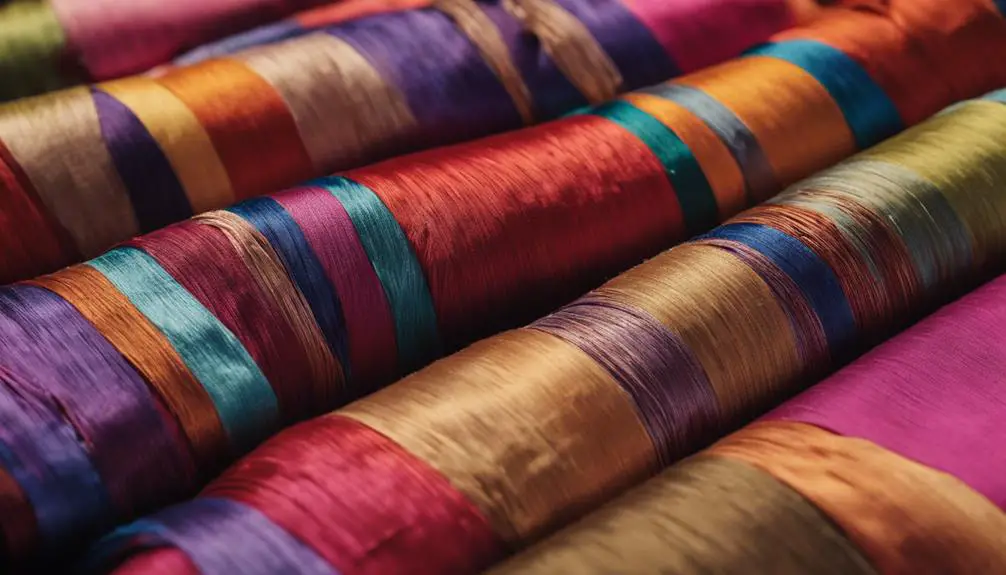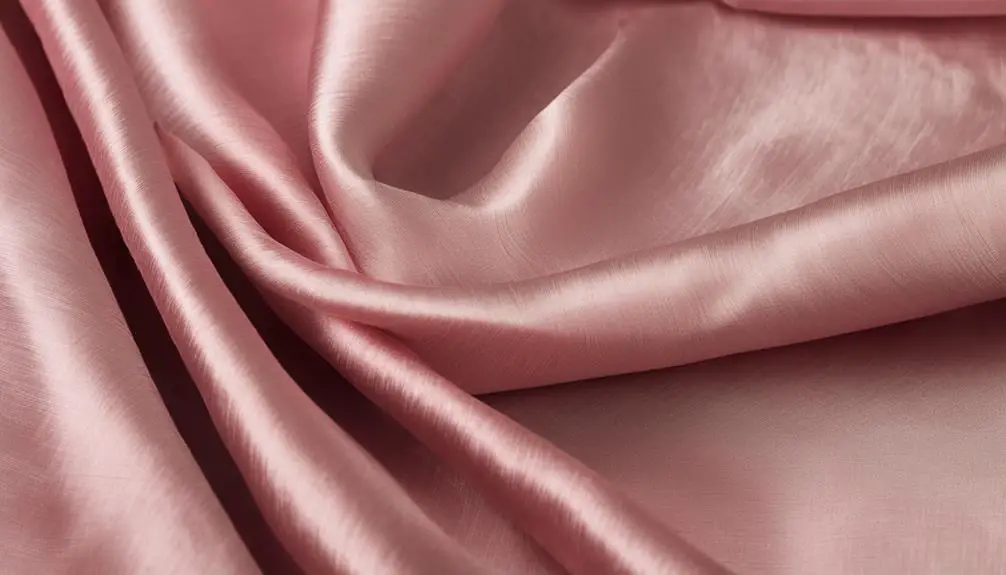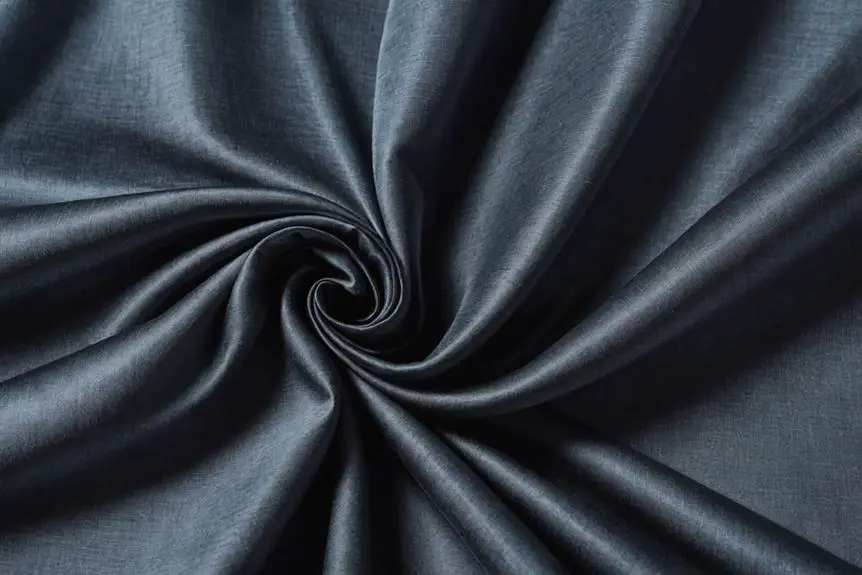When you're trying to identify Shantung silk fabric, you'll want to start by examining its unique texture. You should look for a lightly pebbled surface and minimal slubs, which set it apart from other silks. Unlike the stiffer dupioni silk, authentic Shantung drapes gracefully and feels lighter in weight. Don't overlook the color variations between the warp and weft threads, as this iridescent effect is a hallmark of true Shantung. But there's more to take into account if you want to verify you're getting the genuine article. What else should you be on the lookout for?
Characteristics of Shantung Silk

When you explore the world of fabrics, you'll quickly notice that Shantung silk stands out due to its lightweight and crisp texture. It's one of those materials that just feels luxurious! You'll find that silk Shantung is known for its elegant draping, making it perfect for flowing dresses or any formal attire you might have in mind. Unlike other silks, like dupioni, Shantung has minimal irregular slubs. This means it has a smoother appearance that feels sophisticated and chic.
As you touch and handle this fabric, you'll notice it's generally thinner than dupioni, giving it that delicate feel. The slight sheen it exhibits—especially on one side—adds a touch of glamour to any garment. Don't you just love how certain fabrics can elevate your outfit? Whether you're eyeing a wedding gown or a special occasion dress, Shantung silk is incredibly versatile.
Historical Background of Shantung
Originating from the Shandong province of China, Shantung silk has a rich history that dates back to the Renaissance period. Isn't that fascinating? The name "Shantung" comes straight from the region where this unique silk fabric was first produced, although the exact origins aren't completely clear.
Historically, Shantung was often overshadowed by those smoother silk weaves that you might think of when you picture traditional silk fabric. But here's the twist: it's recently gained popularity for its distinctive textures and crispness! You know, that lovely feel that makes it special?
Even though Shantung represents less than 1% of silk production worldwide, it's become a favorite choice for wedding gowns and formal attire. Imagine walking down the aisle in a stunning Shantung wedding gown—talk about a showstopper! The production of this fabric is quite unique too. It involves weaving two types of yarn: uniform silk yarn for the weft and slub yarn with irregular nubs for the warp. This combination creates the characteristic appearance that makes Shantung stand out from other silks.
Production Process of Shantung

Shantung silk is typically produced through a meticulous process that starts with cultivating silkworms, which feed on mulberry leaves. It's fascinating, isn't it? These little guys munch away, and once they're ready, you harvest their cocoons. This is where the magic begins!
Once you've got those cocoons, you boil them to take care of the silkworms and free the silk fibers. It's a bit brutal, but necessary for that soft, luxurious fabric we all love. Now, here's where it gets really interesting. In the weaving stage, they use two types of yarn:
- A uniform silk yarn for the weft
- A slub yarn with irregular nubs for the warp
- The combination creates that distinctive texture you see in Shantung silk.
- Before weaving, a dyeing process often happens, adding vibrant colors and patterns to the fabric.
Most of the magic takes place in the Shandong province of China. Did you know that traditional weaving techniques have been honed there for centuries? It's pretty impressive! Each step in the production process contributes to the beauty and quality of silk Shantung, making it a sought-after fabric. So, next time you see that gorgeous fabric, you'll know all the hard work that went into creating it. Isn't that cool?
Common Uses of Shantung Silk
Known for its unique texture and elegant draping, Shantung silk finds its way into a variety of fashion and decor applications. If you're looking to make a statement, this fabric is a fantastic choice! It's often the go-to material for stunning bridal attire, thanks to its crisp texture that gives wedding gowns an exquisite shape. Who wouldn't want to feel like royalty on their big day?
But dresses aren't the only thing this versatile fabric excels at. Shantung silk is also popular in formal menswear, like tailored suits and dress shirts. It adds a touch of sophistication, perfect for any formal occasion. And let's not forget about ladies' evening wear and children's dresses! Whether it's a flower girl dress or a fancy party gown, Shantung silk brings a special charm that's hard to beat.
Plus, its durability means you can wear your favorite Shantung pieces again and again without worrying about wear and tear. Aren't you glad to know it's not just a one-time wonder?
And if you're thinking about home decor, don't overlook this fabulous fabric! Shantung silk makes for stunning upholstery and even fabric flowers that can brighten up any room. So, whether you're dressing up for a special occasion or sprucing up your home, Shantung silk is the way to go. It's practical, beautiful, and oh-so-chic! Why not give it a try?
Identifying Authentic Shantung Fabric

When you're on the hunt for authentic Shantung fabric, look for its distinctive, lightly pebbled surface that features minimal slubs. This unique texture isn't just pretty; it gives the fabric a crisp and elegant feel. But how do you spot the real deal? Here are some tips to help you out:
- Feel the Weight: Genuine Shantung silk is lighter than dupioni silk. If it feels heavy, it might not be authentic. You want something that flows beautifully, perfect for those stunning dresses.
- Check the Drape: An authentic Shantung silk has a smooth drape. It should move gracefully with you, rather than feeling stiff or rigid. Think of how fabulous it'll look on the dance floor!
- Look for the Silk Mark Certification: If you're in India, check for this certification. It's a solid guarantee that the fabric is genuine silk. You wouldn't want to invest in a knockoff, right?
- Examine Color Variation: Authentic Shantung often shows distinct color variation between the warp and weft threads. This creates that gorgeous iridescent effect that's just so eye-catching.
Frequently Asked Questions
What Are the Characteristics of Shantung Silk?
Shantung silk's got a crisp texture that makes it stand out, right? You'll notice its subtle sheen compared to other fabrics, giving it a classy vibe. Plus, it's pretty durable, thanks to its unique weaving techniques. You can find cool color variations too, which add flair! Historically, it's been a favorite for elegant dresses. Just remember to care for it properly, and check market pricing—it's usually worth the splurge! What do you think?
What Is the Difference Between Silk and Shantung Silk?
So, what's the difference between silk and Shantung silk? Well, silk types vary widely! Shantung's got this unique weave that gives it a crisp texture and a slight ribbed effect, unlike the smoother silk. You'll love its flowing fabric uses in dresses, but it's also great for structured pieces! Plus, Shantung comes in fun color variations. Just remember to follow proper care instructions to keep it looking fab! Isn't that cool?
How to Identify Silk Fabric?
So, you wanna identify silk fabric? Start by checking the texture differences; real silk feels smooth and cool, while synthetics can feel warmer. Look for color variations—authentic silk has a natural sheen that changes with light. You can also consider the weaving techniques; different silk types, like dupioni, have distinct looks. Don't forget about sourcing tips—labels are your friends! And hey, remember, fabric care matters for keeping that silk fabulous!
How to Identify Dupioni Silk?
When you're checking out dupioni silk, pay attention to its unique texture—those irregular slubs give it a rustic vibe! You'll love the shiny sheen, perfect for formal outfits. Did you know dupioni is woven with different colored threads? That means you'll spot some awesome patterns and colors! As for care, it's pretty easy; just avoid harsh chemicals. So, whether it's for dresses or décor, dupioni silk's got your back!
Conclusion
Spotting authentic Shantung silk isn't rocket science, but it does take a little practice. Just remember to look for that pebbled surface, smooth drape, and those beautiful color variations. And hey, if you see that Silk Mark, you can buy with confidence! Next time you're shopping, put your newfound skills to the test. Isn't it exciting to know you're now a Shantung silk detective? Happy fabric hunting!




